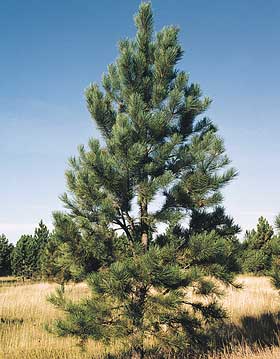
Problem trees are on this list because they have one or more faults: weak wood that breaks in windy conditions, high water use, excessive pollen, invasive roots, are susceptible to insects or disease, or just don’t do well in Sandia Heights. If you avoid trees on this list, your life will be easier!
The following eleven trees will not be approved by the ACC. Details can be found in the ACC Guideline for Landscaping.
Cottonwood Russian Olive Salt Cedar
Siberian Elm Box Elder Tree of Heaven
Ponderosa Pine Lombardy Poplar Silver Maple
Mulberry Cypress
The remaining trees on this iist are for sale in local nurseries and may even be proposed by landscape contractors, but are not recommended because of various problems:
Arborvitae Thuja species According to landscape architect and author Howard Garrett, “every insect known to man either eats or lives in this plant”.
Aspen Populus tremuloides
Not happy below 7000’ elevation. Sandia Heights is about 6000’ - 6400’, and aspens get stressed from heat, suffer from leaf scorch, and are short lived as a result.
Birch, River Betula nigra
Sometimes sold as a substitute for aspen, but does not do well in Sandia Heights. High water use, yellowing leaves in our alkaline soil, short lived, leaves get windburned and scorched in our strong sun and wind.
Magnolia Magnolia species
This Eastern tree prefers acid soil and becomes chlorotic in our alkaline soil. It's a great tree for the South, but doesn't do well here and looks out of place in Sandia Heights.
Chitalpa Chilopsis x Catalpa
Cross between Catalpa and native Desert Willow, with none of the good qualities of the Desert Willow and all of the negative qualities of the Catalpa. Poor structure, root rot with overwatering, catalpa moth caterpillar.
Green Ash Fraxinus pennsylvanica
Susceptible to ash borer and ash white fly, high water user, breaks easily, pest-prone. Other ash varieties (Raywood, Fragrant) are better choices.
Purple Robe Locust Robinia pseudoacacia 'Purple Robe'
Poor structure, invasive roots, suckers, brittle branches, pest-prone. Note that this is not the same tree as the more desirable native New Mexico Locust, Robinia neomexicana.
Purpleleaf Plum Prunus cerastifera
Short lived tree with poor structure, highly susceptible to freeze damage, shallow roots make it vulnerable to blowing over in high winds, very susceptible to pests.
Globe Willow Salix matsudana
Grows fast but dies easily and quickly, has weak wood, poor structure, high water use, and is prone to pests.
Weeping Willow Salix species
Tempting because it grows fast and looks good, but short lived with brittle wood and invasive roots. Requires moist soil at all times. Susceptible to borers and root rot.